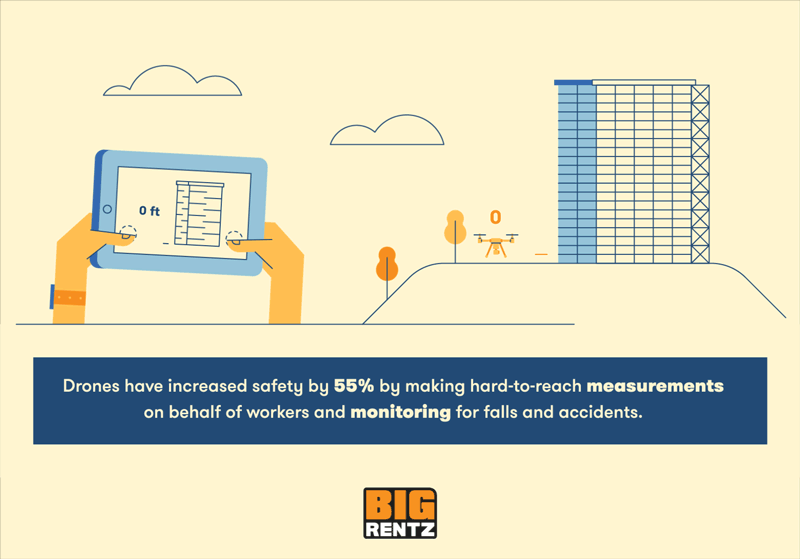 This post by Lior Zitzman originally appeared on the Big Rentz blog. We thought that it presents some good background for the ways that drones are being used in the industry and that you might be able to use it in your decision making for ways to integrate drones into your business.
This post by Lior Zitzman originally appeared on the Big Rentz blog. We thought that it presents some good background for the ways that drones are being used in the industry and that you might be able to use it in your decision making for ways to integrate drones into your business.
Drones have become one of the hottest trends in the construction industry in recent years. Growing at a rate of 239% each year in the industry, drones are quickly becoming essential tools on the job site.
The aerial vantage and data recording abilities of drones allow them to revolutionize the entire construction project lifecycle, offering benefits like on-site safety, real-time updates, remote monitoring, and more efficient project scoping. As construction projects become more complex and grander in scale, the drone market will continue to boom and impact the entire industry.
Read on to learn more about how these futuristic devices are transforming construction job sites.
Which Drones Are In the Industry?

Construction drones are generally equipped with cameras, GPS units, thermal sensors and infrared sensors that allow them to capture key details about the physical site. The drone can then communicate with a computer via software, allowing users to analyze, interpret, and data that the drones captured.
With their streamlined shape, fixed-wing drones are most effective at scanning and mapping lands over long distances. Rotary drones, on the other hand, have rotating propellers that help them survey and inspect over shorter distances and more inaccessible locations. Selecting the right drone will depend on your usage.
Key Features of Drones

How Construction Companies Use Drones
Construction companies use drones to decrease costs, streamline workflow, ensure safety, and overall improve efficiency, which remains one of the industry’s biggest challenges. Here are some of the ways drones are impacting construction companies.
Land Surveys & Topographic Maps

With their aerial abilities, drones can efficiently survey large sections of land in a matter of minutes, dramatically decreasing the time, costs, and errors of conducting a manual survey. The surveys can shaped into topographic maps and 3D models using drone software. Construction companies use these models to accurately scope out a project, present more compelling bids, and prevent any building mistakes down the line.
Remote Equipment Management
![]()
Instead of manually tracking forklifts and boom lifts with lengthy spreadsheets, construction managers use drones to remotely find the locations of all equipment. This allows them to efficiently manage their equipment fleet and determine the optimal use for each vehicle.
Real-Time Progress Reports

Drone cameras can capture detailed high-resolution photos for use in progress reports. This not only helps to keep stakeholders and clients in the loop, but also goes a long way in improving customer communication and satisfaction. The progress reports can also promote better collaboration among site workers, design teams, engineers, and managers.
Remote Equipment Surveillance

Equipment theft is a common issue that can cost construction companies millions of dollars. Operators can use drone surveillance cameras to make sure that their equipment is securely stored keep an eye out for any unauthorized individuals lurking around the job site.
Personnel Safety Monitoring

Falls are the most prominent cause of injuries and deaths in the construction industry. Rather risking their safety, construction workers use drones to make challenges measurements and reach precarious areas of the job site. Managers can also use drones to track their workers and ensure they operating in a safe, hazard-free environment.
Structure Inspection and Maintenance

Replacing heavy machinery and bulky scaffolding, drones can provide crucial inspection. They can be flown around structures to check stability and fine details, and take high-resolution imagery for analysis. Thermal sensors can detect heat leaks, cold spots, and any electrical issues. This level of quality assurance helps with client relationships in the long run.
Drones can also be used for planned maintenance of larger-scale structures like bridges, towers, roofs, and scaffolding. A task that would take an entire team of surveyors to do would only take a few hours with a drone operator.
While drones in construction aren’t new, construction companies are adopting them at a faster rate than ever before. Whether they are being used to conduct land surveys or to keep track of equipment, drones have proved invaluable to the field.
Drones also have direct benefits to the construction lifecycle. Their capabilities allow them to cut costs, time, risk, and labor, all while improving workflow, accuracy, communication, and efficiency. All these lead to more confidence and certainty when working on a construction project.
While the impact of drones in the construction industry is developing, they are already revolutionizing the sector and changing the way construction projects are handled. As long as the technology is able to pass federal aviation and zoning hurdles, it is safe to say that the commercial drone is here to stay.


